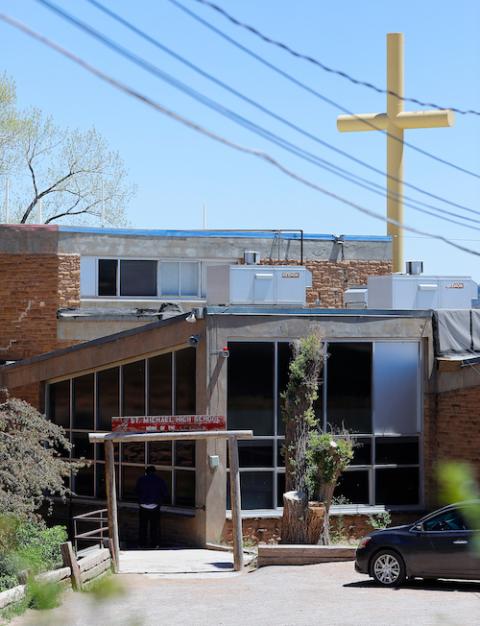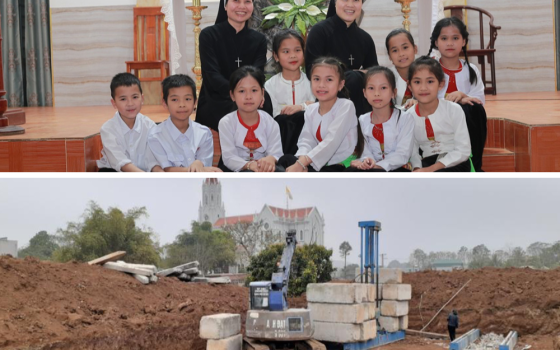
A girl accepts hot lunches from Kiara Hardy outside St. Michael Indian School in the Navajo Nation May 5. The school is distributing breakfasts and lunches for its students and other children in the area during the COVID-19 pandemic. (Nancy Wiechec)
Loneliness, grief and hope.
Emotions run high as St. Michael Indian School continues distance education and feeding students during the COVID-19 lockdown.
"It's sad. It's lonely," said 32-year-old principal Tazbah Yazzie. "We are used to seeing our kids every day, seeing their smiles, their faces. … Now, it's very, very different. I don't hear their chatter, their laughter. It's just silent. I miss them."
The novel coronavirus has hit the Navajo Nation especially hard. With a population of about 200,000 in an area a bit larger than West Virginia, the reservation's COVID-19 death rate has been higher than every U.S. state except for New York, New Jersey, Connecticut and Massachusetts.
As of May 6, the virus has infected more than 2,654 people in the Navajo Nation, which has reported 85 lives lost to COVID-19. In Arizona's Apache County, where St. Michael's mission and school are located, more than 671 people have tested positive for the virus. Many Navajo families, including Yazzie's, have lost relatives to COVID-19.
School buildings and some businesses are closed, and the nation is facing its fifth mandated weekend lockdown. Along with nightly 8 p.m. curfews, the stay-home orders are to prevent further spread of the disease.

Homes on the Navajo Nation are seen outside of Leupp in Arizona. The nation is nearly all rural covering an area of more than 27,000 square miles. Before the coronavirus pandemic, 43% of households were living below the U.S. poverty rate. (Nancy Wiechec)
Nation officials say their people are more prone to the spreading virus because of close familial ties and limited health services. Navajo Nation President Jonathan Nez explained the issues in a recent interview with KOAT Action News in New Mexico.
"You have multiple generations of family members under one roof, so if one individual gets COVID-19, we don't want them to go back into the household. But because of the limits of hospital beds throughout the Navajo Nation, the underfunding of the Indian Health Services, we sometimes have to send our COVID-positive patients back home."
Reservation households lack many modern conveniences. Much of the rural population lives in poverty without running water or reliable internet service. Mobile phone service is available in more populated parts but does not cover the entire reservation.
"[Navajos] just don't live like the rest of America lives," said Dot Teso, president of St. Michael Indian School. "Homes are small, with grandma, aunt and uncle living with the rest of the family. … It's very hard to curb the spread of something like coronavirus in these conditions."
In good times, the Navajo Nation is often referred to as a "food desert" because it lacks enough grocery stores to serve its people. Families often travel outside the reservation to Gallup, New Mexico, or Flagstaff, Arizona, for food and other necessities. Water must be hauled in by truck. With the recent lockdowns, food and water is even more difficult to come by.
Advertisement
St. Michael School helps feed its community by providing weekday breakfast and hot lunch for students and other local children. But the novel coronavirus even disrupted that endeavor when a staff member tested positive for the virus.
Teso said the school shut down its drive-by meal service for more than a week to thoroughly disinfect the food prep areas and make sure the rest of the staff was not ill.
"Our food service manager began to cry when she found out we had to stop the meal program," she said. "We're just in hyper-sensitive mode, wanting to do all we can."
They restarted the meal service on May 4.
"As the Catholic Church, we are called to serve," Teso remarked. "We can reach out with meals for children in our community, and we'll continue to do that while being extra cautious."
Founded by pioneer educator St. Katharine Drexel, St. Michael Indian School has been educating Navajo children since 1902. Yazzie, with degrees from the University of Notre Dame and the University of Phoenix, is the school's first Navajo principal.

St. Michael Indian School, which educates students in preschool through grade 12, sits quiet May 5. (Nancy Wiechec)
When she speaks about St. Michael's students, she's energetic and hopeful. Yet, her voice cracked and tears welled up in her eyes when she talked about the present state of loneliness in Navajo communities.
"Everything is done at a distance," she said. "It's very hard to try and be there for a family member when they're sick. You can't be there in the same room with them. That took a toll on my husband's family. They tried to maintain a strong bond with an ill person in his family … but unfortunately, she passed away."
Despite the grief, the principal and her teachers push forward, making sure pupils continue lessons and achieve the goals the school has set for them, which include a college education.
For most households in the Navajo Nation, online learning is not possible because many homes do not have reliable internet service or computers. Yazzie said she offered digital learning packets, but fewer than 30 of the school's 364 students took her up on those. Most are receiving take-home paper lessons.
Teachers put curated lesson plans into packets every three weeks for pick up outside the school. Parents receive new materials and drop off completed work at a makeshift stand.
"It's insane, but we have a process," said Teso. "We make it work."
Yazzie and her teachers reach out to parents and students by phone or Zoom meeting each week with encouraging messages and help. They also post videos to Instagram letting students know they are thinking about and praying for them.
"I've stressed with our teachers to communicate with parents as much as possible," Yazzie said. She said hearing that kids are motivated to do school work at home is very encouraging.

St. Michael Indian School principal Tazbah Yazzie waves to students as she records a video to post on the school's Instagram page May 5. Children continue to receive their education through at-home learning while the school buildings remain closed during COVID-19 pandemic. (Nancy Wiechec)
School administrators are now working on the plan for when children return to school. Teso said they will follow Navajo Nation directives on when and how to get back into classrooms. Still, she expects to see children on campus again for the fall semester in September.
Yazzie and Renee Tsinnie, the school's development director who helps coordinate the school's cheer squad, were outside as parents and students drove up to collect lesson packets May 5. They waved their gloved hands heartily when they recognized students.
"Oh, I just want to hug her," said Tsinnie as one SUV drove away down a dusty road. Standing 6 feet away, she had a chance to chat with a girl on the cheerleading squad. She hadn't seen her in weeks.
"It's good to keep sharing the good news," said Tsinnie as she explained some of the ways the school community has celebrated successes in a time of social separation. "Everybody's trying to find that hope, keeping hope alive."
[Nancy Wiechec is a veteran Catholic journalist and photographer working from northern Arizona.]
Slideshow:
More about the Navajo Nation
The Navajo Nation extends into parts of Arizona, New Mexico and Utah, covering more than 27,000 square miles on the Colorado Plateau. Geographically, it is the largest American Indian reservation in the United States. According to the nation, 200,000 people live within its boundaries.
The Navajo Nation is composed of five agencies and 110 local government chapters. St. Michael Chapter is named for the mission established by Franciscan friars in 1898. The chapter includes Window Rock, home of Navajo Nation's governing body and the Navajo Nation Museum and Visitor's Center.
The Diné (Navajo people in their native language) are known worldwide for their handwoven rugs as well as sand paintings and silver and turquoise jewelry. Tourists come through the nation to experience the beauty of Monument Valley, Antelope Canyon, Canyon de Chelly and other scenic wonders.
Navajos take pride in the contributions they've made to the United States. They are especially proud of the Navajo Code Talkers, Navajo men who provided secret military communications based on the Navajo language during World War II.
Before the novel coronavirus pandemic, unemployment in the nation was between 40% and 50%, with 43% of households living below the U.S. poverty rate. Nearly all of Navajo country is rural. A lack of clean and running water, an Americanized diet, minimal access to health providers, poverty, alcoholism and uranium contamination hamper health and well-being on the reservation.
Traditional Navajo religion intertwines with nature, art, ritual and ceremony. Some Navajos have adopted Christianity, and Christian churches, missions and schools appear across the reservation. At least nine are Catholic.
Navajo Nation Catholics host a Facebook page, with information on the Navajo missions and people.
—Nancy Wiechec












